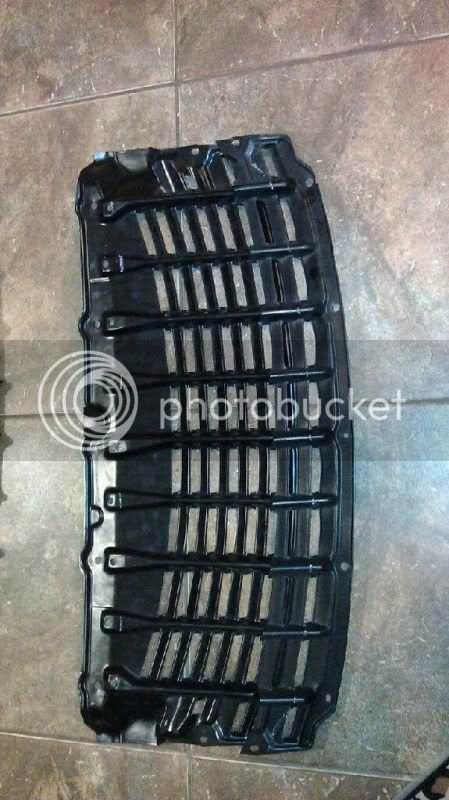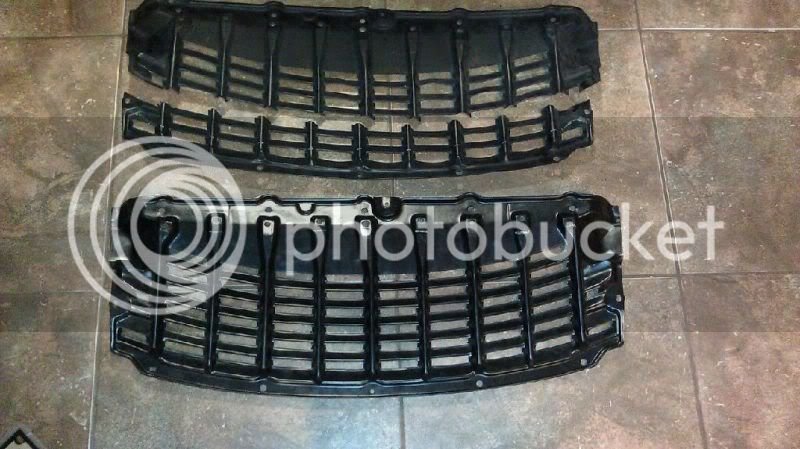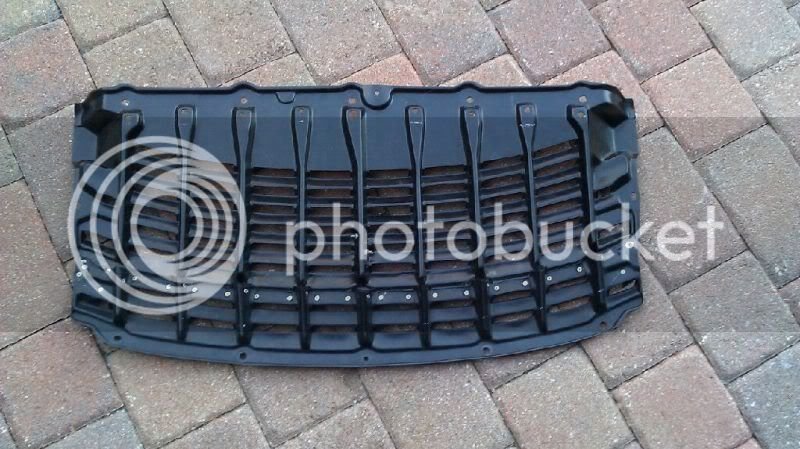Ryan knows much of the following but for thread reader clarification:
The stock parts are designed to funnel air from the high pressure areas in front and below the front bumper, channel this pressurized air to the A/C and radiator cores and then have a relatively lower pressure area for the air to escape which is why the air flows through.
STOCK parts are sufficient for stock cooling when the vehicle is used as intended and there will be some degree of "extra" capacity engineered into the design in case the owner lives and drives in harsh conditions.
If you take a stock car to a racetrack and drive it as hard as possible you can usually uncover the limits to the stock engineering. Brakes are usually the first part of a stock car to exceed engineering limits with cooling of engine temperature, oil temperature and transmission temperature (not necessarily in that order) reaching limits next.
Heat management is the result of component design, packaging and power levels reached and the duration of power use. If you decrease the efficiency of the stock system you will reach the limits sooner even with stock power and use. When adding components such as an intercooler (or other coolers or components) into the area the engineers use for stock cooling air flow the efficiency of the stock design is reduced. When the intercooler (or other components) ADD additional heat to the now reduced air flow the reduction in efficiency is compounded. Even with stock power levels the margin can be crossed and overheating occur. With decreased cooling efficiency and increased power levels it becomes clear that a system that is better than stock should be engineered.
Ryan made reasonable choices with an upgraded radiator. His turbo system packaging leaves little room for cooling fans so the electric ones were required. His impressive goals have had the car in an unfinished state for an extended period of time. His eagerness to drive the car is completely understandable. In doing so without the from bumper cover the car was able to be driven without overheating. Adding the cover without the remainder of the stock air management parts caused overheating. Replacing the stock air management parts (which required some modification for fitment) and changing the electric fans looks to have made the car drivable without overheating. The question now would be is there sufficient margin to operate with increased power?
The pictures of ducting that I posted earlier are examples of racecar engineering both amateur and professional. Understanding the flow of air as it reaches the car, moves through the system and then exits the car is fundamental in designing an improved (better than stock) system. For this application where the goal is considerable power I would look to make improvements.
The front of a car compresses then air as the vehicle moves through it. This creates high pressure at the front and this pressure is what is mostly used by stock engineers. As the air flows over the hood it is accelerated and the pressure drops. This is why some racecars have EXIT ports in the hood to allow air an outlet from the BACK of the radiator area. At the windshield the air is again compressed and another area of pressure is available and some cars duct this area to the engine inlets to give the engine higher pressure air increasing power.
Air flow over the top of a car accelerates the air decreasing pressure. This can be seen on many older cloth top convertibles where the top "bulges" up from the pressure decrease. If enough air is allowed to flow under the car the difference in pressure between under and over the car actually creates LIFT just like an airplane wing. NASCAR cars have air dams at the front to prevent as much air as possible from going under the car. This worked great UNLESS the car lost control and slid sideways. This allowed air under the car as well as over the car and turned the car into an "airplane wing". This "wing" going 150+mph had plenty of lift and cars took off and became airborne. NASCAR implemented "flaps" to combat this problem and these can be seen popping up to bleed off pressure when a car slides sideways preventing this from happening.
Back to cooling.
As MUCH of the available high pressure air at the front bumper area should be CHANNELED via sealed DUCTING to the cooling cores. The ducting should prevent pressure from escaping to other areas. The goal is maximum pressure feeding the cores. Additional ducting BETWEEN the cores is advisable to keep the air flowing through ALL the cores and not just the intercooler and or the A/C core... Pressure needs to be keep as high as possible to the front of the actual engine coolant radiator core. Added heat from the intercooler and A/C cores makes keeping the pressure even more critical.
Once as much pressure is captured and focused on the cooling cores the next goal is REDUCING pressure at the radiator outlet. All the pressure in the world in front of the cores does no good without a place for the air to flow OUT of the cores. Flow ONLY occurs when the pressure is higher in front of the core than behind it. When the vehicle is not moving fans are required to create this pressure difference. At low speeds the fans are often still needed until a sufficient pressure DIFFERENTIAL is created by vehicle motion.
In some situations the fan(s) and fan shroud will restrict the potential air flow. Engineers add "flaps" that will pop open when this happens. The air behind the radiator can be managed. Creating outlet ducting can increase flow through the cores. This ducting would have outlets where the pressure is naturally LOWERED by vehicle motion. This is why some cars (like the Ford GT40) have radiator vent(s) in the hood. These vents connect to a sealed DUCT from the radiator outlet.
It is great to have a car that can operate without overheating. It is better yet to have a car with MORE cooling capacity than is needed. Attention spent here is time that will not be spent later dealing with the (possibly expensive) ramifications of overheating.



The stock parts are designed to funnel air from the high pressure areas in front and below the front bumper, channel this pressurized air to the A/C and radiator cores and then have a relatively lower pressure area for the air to escape which is why the air flows through.
STOCK parts are sufficient for stock cooling when the vehicle is used as intended and there will be some degree of "extra" capacity engineered into the design in case the owner lives and drives in harsh conditions.
If you take a stock car to a racetrack and drive it as hard as possible you can usually uncover the limits to the stock engineering. Brakes are usually the first part of a stock car to exceed engineering limits with cooling of engine temperature, oil temperature and transmission temperature (not necessarily in that order) reaching limits next.
Heat management is the result of component design, packaging and power levels reached and the duration of power use. If you decrease the efficiency of the stock system you will reach the limits sooner even with stock power and use. When adding components such as an intercooler (or other coolers or components) into the area the engineers use for stock cooling air flow the efficiency of the stock design is reduced. When the intercooler (or other components) ADD additional heat to the now reduced air flow the reduction in efficiency is compounded. Even with stock power levels the margin can be crossed and overheating occur. With decreased cooling efficiency and increased power levels it becomes clear that a system that is better than stock should be engineered.
Ryan made reasonable choices with an upgraded radiator. His turbo system packaging leaves little room for cooling fans so the electric ones were required. His impressive goals have had the car in an unfinished state for an extended period of time. His eagerness to drive the car is completely understandable. In doing so without the from bumper cover the car was able to be driven without overheating. Adding the cover without the remainder of the stock air management parts caused overheating. Replacing the stock air management parts (which required some modification for fitment) and changing the electric fans looks to have made the car drivable without overheating. The question now would be is there sufficient margin to operate with increased power?
The pictures of ducting that I posted earlier are examples of racecar engineering both amateur and professional. Understanding the flow of air as it reaches the car, moves through the system and then exits the car is fundamental in designing an improved (better than stock) system. For this application where the goal is considerable power I would look to make improvements.
The front of a car compresses then air as the vehicle moves through it. This creates high pressure at the front and this pressure is what is mostly used by stock engineers. As the air flows over the hood it is accelerated and the pressure drops. This is why some racecars have EXIT ports in the hood to allow air an outlet from the BACK of the radiator area. At the windshield the air is again compressed and another area of pressure is available and some cars duct this area to the engine inlets to give the engine higher pressure air increasing power.
Air flow over the top of a car accelerates the air decreasing pressure. This can be seen on many older cloth top convertibles where the top "bulges" up from the pressure decrease. If enough air is allowed to flow under the car the difference in pressure between under and over the car actually creates LIFT just like an airplane wing. NASCAR cars have air dams at the front to prevent as much air as possible from going under the car. This worked great UNLESS the car lost control and slid sideways. This allowed air under the car as well as over the car and turned the car into an "airplane wing". This "wing" going 150+mph had plenty of lift and cars took off and became airborne. NASCAR implemented "flaps" to combat this problem and these can be seen popping up to bleed off pressure when a car slides sideways preventing this from happening.
Back to cooling.
As MUCH of the available high pressure air at the front bumper area should be CHANNELED via sealed DUCTING to the cooling cores. The ducting should prevent pressure from escaping to other areas. The goal is maximum pressure feeding the cores. Additional ducting BETWEEN the cores is advisable to keep the air flowing through ALL the cores and not just the intercooler and or the A/C core... Pressure needs to be keep as high as possible to the front of the actual engine coolant radiator core. Added heat from the intercooler and A/C cores makes keeping the pressure even more critical.
Once as much pressure is captured and focused on the cooling cores the next goal is REDUCING pressure at the radiator outlet. All the pressure in the world in front of the cores does no good without a place for the air to flow OUT of the cores. Flow ONLY occurs when the pressure is higher in front of the core than behind it. When the vehicle is not moving fans are required to create this pressure difference. At low speeds the fans are often still needed until a sufficient pressure DIFFERENTIAL is created by vehicle motion.
In some situations the fan(s) and fan shroud will restrict the potential air flow. Engineers add "flaps" that will pop open when this happens. The air behind the radiator can be managed. Creating outlet ducting can increase flow through the cores. This ducting would have outlets where the pressure is naturally LOWERED by vehicle motion. This is why some cars (like the Ford GT40) have radiator vent(s) in the hood. These vents connect to a sealed DUCT from the radiator outlet.
It is great to have a car that can operate without overheating. It is better yet to have a car with MORE cooling capacity than is needed. Attention spent here is time that will not be spent later dealing with the (possibly expensive) ramifications of overheating.














